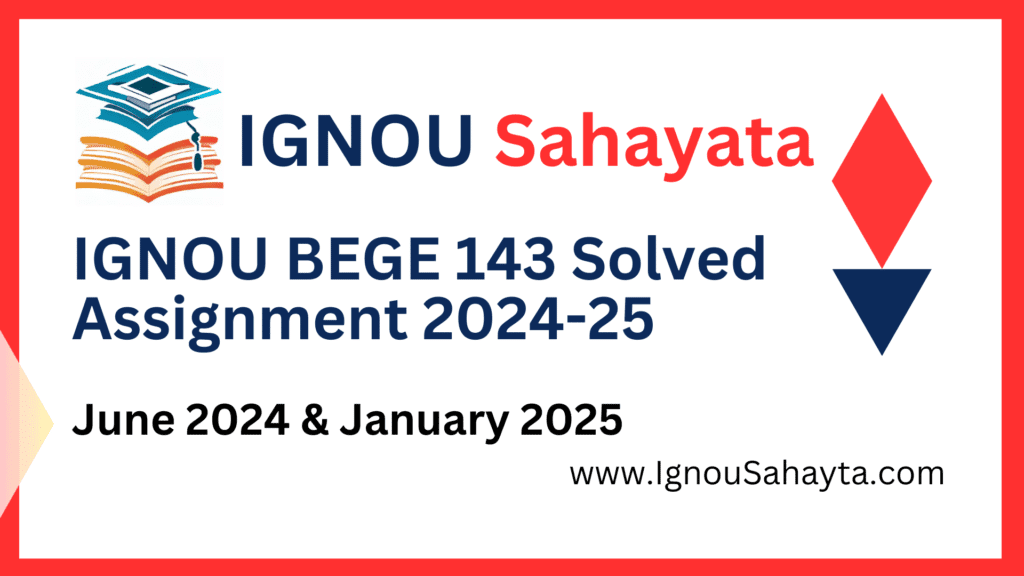Presenting the most recent update to our collection of IGNOU BEGE 143 Solved Assignment 2024–25 PDF Download resources! You are at the correct location if you are enrolled in the BEGE 143 course for the Indira Gandhi National Open University (IGNOU) Bachelor of Arts (General) program. English and Hindi-language assignments are available from us. You may approach the problems this course presents with confidence and accuracy if you use this painstakingly created Solved Assignment PDF.

We explore the fundamental ideas, assignments, and concepts that underpin this course as we delve into the details of IGNOU BEGE 143 in this extensive guide. Our Solved Assignment PDF offers thorough answers and insights to any problems you may be having with challenging subjects or looking for clarification on assignment criteria.
The IGNOU BEGE 143 Solved Assignment 2024–25 PDF Download gives you access to professionally written answers that meet IGNOU requirements. Bid farewell to ambiguity and doubt and welcome to a methodical approach to learning your content and succeeding in your academic endeavors.
Click To Download Full IGNOU BEGE 143 Solved Assignment
BEGE 143 Solved Assignment 2024-25 Hindi Medium
BEGE 143 Solved Assignment 2024-25 English Medium
IGNOU BEGE 143 Solved Assignment 2024-25
The BEGE 143 course on Understanding Poetry is designed to provide students with a comprehensive understanding of the poetic form, its structure, themes, and techniques. Poetry, with its unique rhythm, meter, and language, often communicates emotions and ideas in a condensed and expressive form. The assignments for this course typically require students to explore the various elements that make poetry distinct, including form, style, and the use of literary devices such as metaphor, simile, alliteration, and imagery. By studying different types of poetry, students are able to grasp the nuances of this literary form and its power to evoke deep emotions.
One significant focus of the course is the structure and form of poetry. Poets use different forms to convey meaning, and understanding these forms is crucial for interpreting the poem’s message. For example, a sonnet’s structured 14 lines follow a specific rhyme scheme, which can highlight the subject matter’s emotional intensity. Similarly, free verse poetry, which lacks a fixed pattern, gives the poet more freedom to express complex ideas in a less constrained way. Assignments often explore the significance of rhyme, meter, and line breaks in shaping the poem’s meaning and rhythm, and how these elements work together to enhance the reader’s experience.
Another vital aspect of the course is the analysis of poetic devices. Poetry relies heavily on various techniques such as metaphor, simile, symbolism, and personification to convey its deeper meaning. Through assignments, students are encouraged to analyze how these devices are used to express complex emotions or ideas in a more vivid and impactful way. For example, a metaphor in a poem can represent an abstract concept, making it easier for the reader to understand and connect with. Exploring these techniques helps students appreciate the subtleties of poetic expression and gain a deeper understanding of how meaning is created in poetry.
Themes and interpretation of poetry are also essential components of the course. Poetry often explores universal themes like love, death, nature, and identity. By analyzing these themes, students can interpret how different poets approach common human experiences. The assignments may involve examining how a particular poet’s work reflects societal, cultural, or historical contexts. For instance, students might study the works of poets like William Blake or Sylvia Plath to understand how their poetry addresses the themes of personal and societal struggle. Understanding the theme allows students to connect with the poem on a deeper level and appreciate its relevance.
Finally, the emotional and aesthetic impact of poetry is central to this course. Poetry has the ability to move readers emotionally, often through its rhythm, sound, and choice of words. Students are asked to consider how the poet’s use of language creates an emotional experience. For example, the repetition of sounds or words can emphasize particular emotions or ideas. By engaging with the poem’s emotional landscape, students are encouraged to reflect on the transformative power of poetry in both personal and universal contexts. Through such assignments, the course aims to cultivate a more profound appreciation for the art of poetry and its enduring power to inspire, provoke, and challenge readers.